Here is a list of key sources for the above and other elements of the project.
Every death on every road in Great Britain 1999-2010
-
 Three million
Three million
-
 The one percent
The one percent
-
 Rush-hour danger
Rush-hour danger
-
 Twin peaks
Twin peaks
-
 Dangerous driving
Dangerous driving
-
 Motorways
Motorways
-
 Trunk roads
Trunk roads
-
 Localism
Localism
-
Three million
During the 12 years to 2011, the police recorded more than three million road casualties in Great Britain.
More than 36,000 people lost their lives and another 373,985 were seriously injured.
However, the police figures do not reflect the full scale of death and injury on the roads. Many incidents go unreported.
The best official estimate of the total number of people killed and injured in road collisions each year is a massive 730,000.
While the price paid by the victims and their familes is inestimable, the annual cost to the economy is between £15bn and £32bn.
1 of 8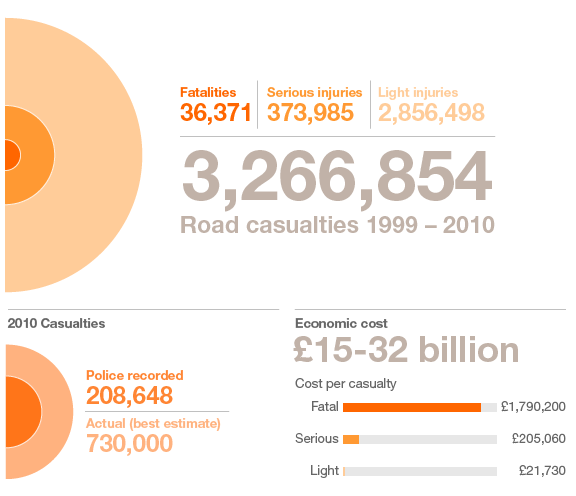
-
The one percent
Riding a motorbike can be dangerous. Our data shows a total of 7,004 bikers and their pillions lost their lives between 1999 and 2010.
Motorbikes account for just 1% of road traffic, but over a fifth of all fatalities, a casualty rate that is 61 times greater than that for cars.
Our research suggests the riskiest time for bikers and their pillions is the weekend when fatalities are considerably higher than during the week.
The pattern during week days is very similar, showing peaks in the morning and afternoon rush hours.
On the weekend however the number of people dying is much higher, particularly on Sunday afternoons.
2 of 8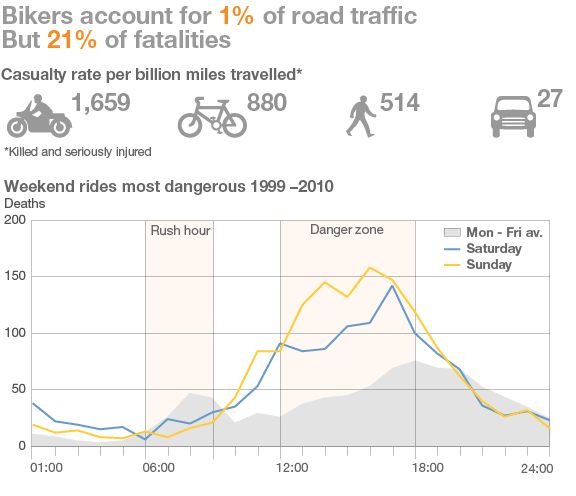
-
Rush-hour danger
Pedestrians are among the most vulnerable road users and have a high casualty rate.
Though the annual numbers killed have come down over the decade our data, show that 8,242 pedestrians died on the roads between 1999 and 2010. This includes 1,279 children.
When roads are at their busiest overall casualty figures rise because of the sheer volume of traffic. Pedestrian casualties peak during afternoon rush hour and school closing time and on Friday and Saturday evenings.
The map shows deaths involving pedestrians and buses on London's world-famous Oxford Street between 1999 and 2010. Oxford street has a high volume of pedestrians and the road is largely restricted to taxis and buses.
3 of 8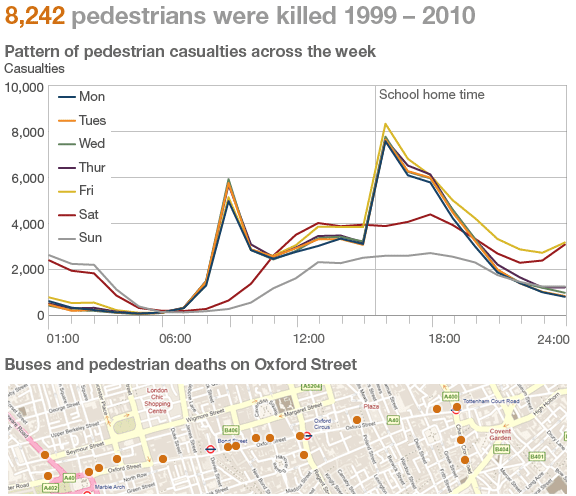
-
Twin peaks
Cyclists have a higher casualty rate than pedestrians. In our data, 1,575 cyclists died on the roads between 1999 and 2010.
The greatest number of cyclists are killed or injured during the morning and evening rush hours on a week day.
You can clearly see the twin peaks around these times in the graph compared with the casualty toll for Saturdays and Sundays.
Though the number of cyclists killed has come down over the years the annual toll fluctuates considerably.
After initially falling in our period, it rose for several years then dipped but has risen again in 2010.
4 of 8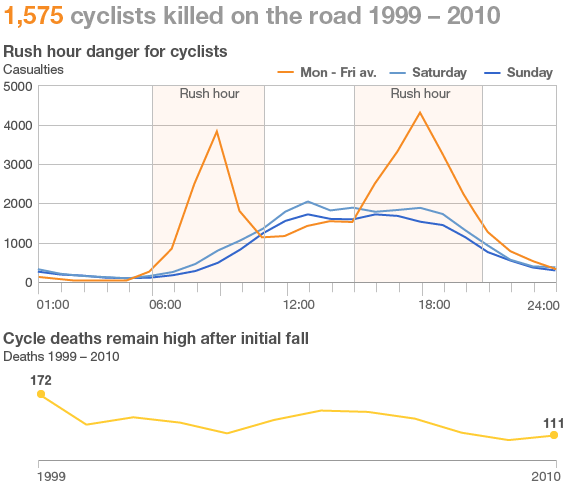
-
Dangerous driving
For every fatal collision, there is a one in two chance that the driver responsible has a criminal record, according to preliminary research by South Yorkshire police.
A different study into the link between drivers involved in collisions and their recorded motoring offences or criminal histories has made some striking findings.
The researchers found that van drivers and truckers involved in a crash are amongst the most likely to have either a motoring offence or a criminal record.
Engaging in a risky activity such as crime, seems to indicate a readiness to take risks behind the wheel, the researchers say.
5 of 8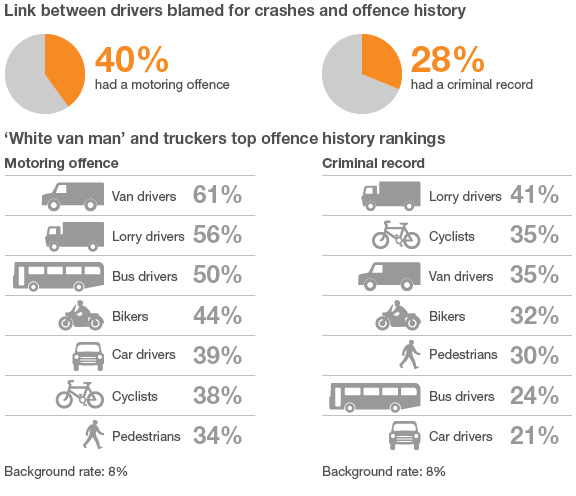
-
Motorways
Statistically, motorways are among the safest roads on which to drive.
Traffic travels in the same direction on the same side of the road. The difference in speed between vehicles is less than on other roads.
They are not crash-free however. When there are collisions, this can result in heavy loss of life, as in the recent M5 crash when seven people died
Trouble tends to cluster around junctions where vehicles join or leave the motorway. This may explain the high rate of crashes on shorter stretches of motorway with many junctions.
The A167(M), a short urban stretch of motorway in Newcastle had the highest number of crashes in our data.
6 of 8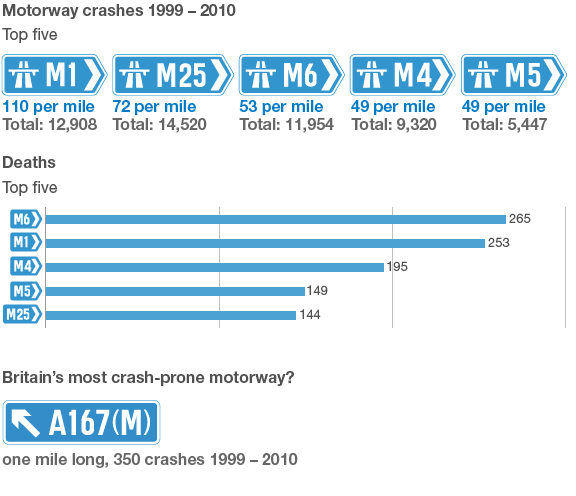
-
Trunk roads
A-roads are more dangerous than motorways when comparing deaths per mile - in our data the death rate on motorways is typically around one per mile.
They are more diverse than motorways, ranging from city centre roads to dual carriageways. Collisions cluster around hazards such as junctions, crossing points and stretches of two lane road.
Major trunk roads top the list for crashes as they carry a lot of traffic. Many also pass through urban areas where traffic can be dense and vulnerable road users such as pedestrians and cyclists share these roads.
The A406, London's north circular, carries a lot of traffic and runs through densely populated areas.
7 of 8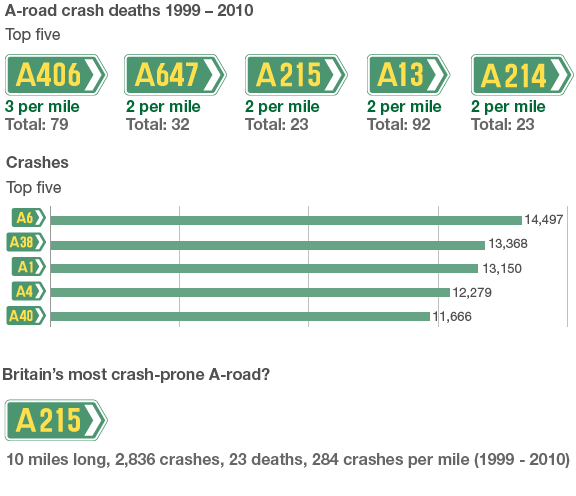
-
Localism
The government wants local authorities to take on more responsibility for reducing road casualties.
This map shows which authorities have the highest and lowest casualty rates.
London boroughs top the list for high rates. In part, this is down to population density and heavy traffic flow in the capital. Deprivation is another factor linked to high casualty rates.
Some rural areas may appear safer but others rank higher due in part to the fatalities and serious injuries that occur on fast country roads.
Cardiff stands out amongst urban areas. City officials say the low numbers are down to better road engineering, lower levels of traffic and enforcement.
8 of 8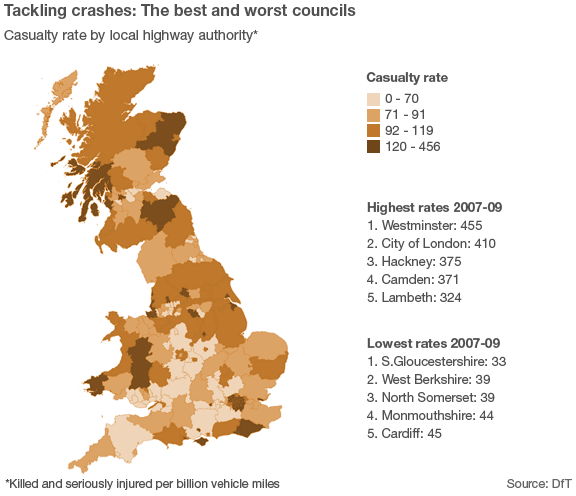
~RS~q~RS~~RS~z~RS~06~RS~)

 MPs warn on growth of UK jihadists
MPs warn on growth of UK jihadists